Two systems are highlighted here A) Copper Oxalate B) Calcium Carbonate and development on thermodynamic modeling of the alumina-water system is currently being completed.
A) Copper Oxalate
The precipitation kinetics of copper oxalate was simulated using a detailed description of the properties of the CuC2O4 electrolyte solution. These include the effect of various ions present in solution, ion-pairs and various complexes determined using an accurate and appropriate thermodynamic model for the chemical system under study. The thermodynamic solubility data used for the precipitated powder in water include the effects of complexation (hydroxo, and oxalato complexes), ionic strength and the simultaneous presence of several solids, that shows an important influence on the kinetic behaviour, by assuming a series of quasi-equilibria.
The correlation of precipitation kinetics were made with experiments carried out in a well mixed mini-batch reactor of 20 mL where CuC2O4 precipitation occurs upon mixing of Cu(NO3)2 and Na2C2O4. Experimentally, the pH behaviour was monitored as a function of time and compared with the theoretical predictions. The system shows a non trivial behaviour with the formation of various complexes during the precipitation reaction and even the possible presence of several solid compounds such as the basic carbonates.
It was only possible to simulate the experimental pH behaviour by taking into account the possible precipitation of secondary carbonate phases such as malachite and azurite. The thermodynamic model predicts that a small quantity (0.4% wt) of malachite is sufficient to alter significantly the pH evolution during the precipitation process. This small amount of a secondary phase could not be detected experimentally.
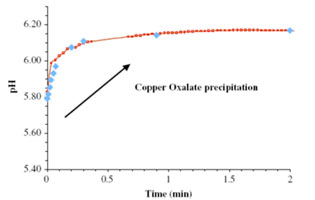 |
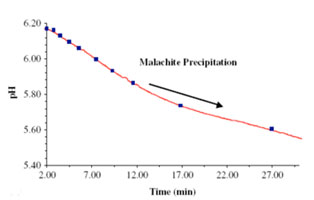 |
|
pH behaviour for the precipitation reaction with pCO2 = 3.3×10-4 bar – comparison between theory (lines) and experiment (symbols)
|
|
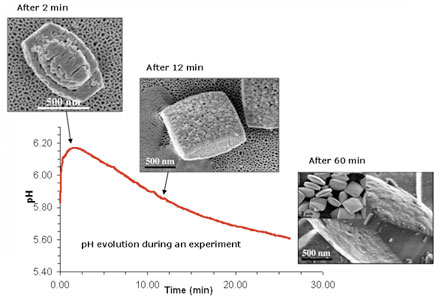
This was done using a hypothesis of two regimes of precipitation; first, only the precipitation of copper oxalate, followed by the formation of a second compound, the hydroxy-carbonate malachite.
B) Calcium Carbonate
Thermodynamic solubility calculations are normally only related to thermodynamic equilibria in solution. In this work, we extend the use of such solubility calculations to estimate the interfacial energy of particles using only solubility data by a modification of Mersmann’s approach. By considering precipitation reactions as a succession of small quasi-equilibrium states, precipitation pathways and thus mechanisms can be better understood by calculating the evolution of surface charge, particle size and/or interfacial energy during the ongoing reaction. The approach includes the use of the Kelvin’s law to express the influence of particle size on the solubility constant of precipitates, the use of Nernst’s law to calculate surface potentials from solubility calculations and relate this to experimentally measured zeta potentials. Calcium carbonate precipitation and zeta potential measurements of well characterised high purity calcite have been used as a model system to validate the calculated values. The clarification of the change in zeta potential on titration illustrates the power of this approach as a tool for reaction pathway prediction and hence knowledge based tailoring of precipitation reaction..
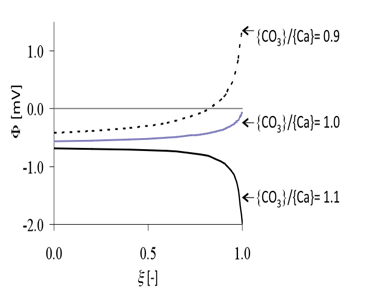 |
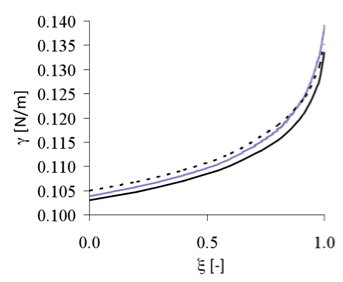 |
| Predicted – surface potentiel of the calcite powder during the reaction progress | Predicted change in interficial energy evolution during the precipitation of calcite |
The thermodynamic modeling was validated and calculations made to simulate possible reaction pathways of a precipitating system; the solubility calculations provide full knowledge of solution composition during the precipitation progress. We considered the case of initial solution composition variations close to the equimolar point. The considered reaction is calcite precipitation using calcium nitrate and sodium carbonate as reactants at 0.004M with {CO3}/{Ca} ratios of 0.9, 1.0 and 1.1. The zeta potential profile (above) shows how at a molar ration of 0.9 there is a change in the sign of the surface charge at high reaction conversion which could lead to significant agglomeration. This thermodynamic model has been used to help elucidate possible precipitation mechanism in seeded calcite growth in the presence of Polyacrylic acid. From mass balance and the thermodynamic model the growth of primary particles which then aggregate to form nanostructured calcite particle can be predicted. Also the species in solution as a function of reaction conditions can be predicted.
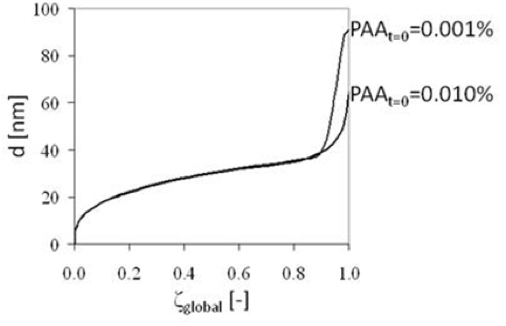 |
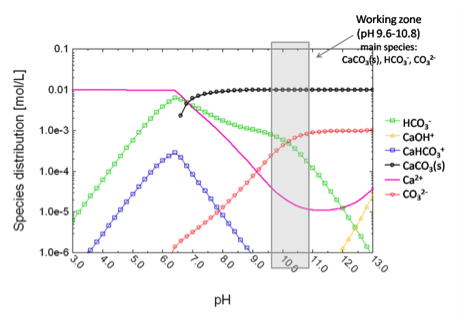 |
| Simulation of the primary particle size with the advancement of the reaction | Evolution of the dominant species in solution in equilibrium with calcite precipitation |
Use of thermodynamic modeling has also helped in the synthesis of nanoszed ZnO (link to nanosized ZnO).
Publications:
- M. Donnet, P. Bowen, J. Lemaître, “A thermodynamic solution model for calcium carbonate: Towards an understanding of multi-equilibria precipitation pathways”, J. Coll.Inter. Sci. 340 (2009) 218–224
- M. Donnet, A. Aimable, J. Lemaître, P. Bowen, Aggregation and Growth Mechanism of Seeded Calcium Carbonate Precipitation in the Presence of Polyacrylic Acid, J. Phys Chem B,114, 12058-12067, 2010